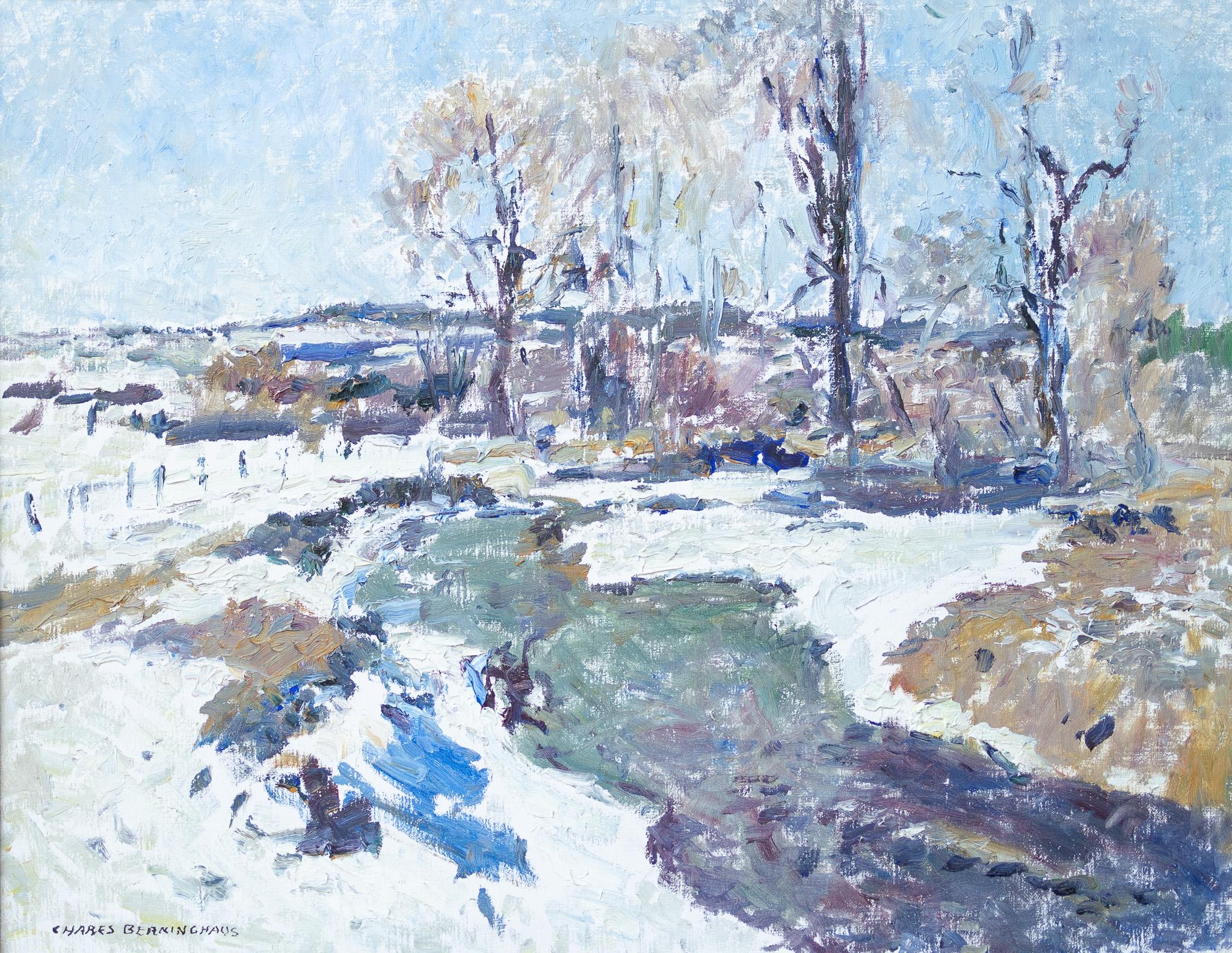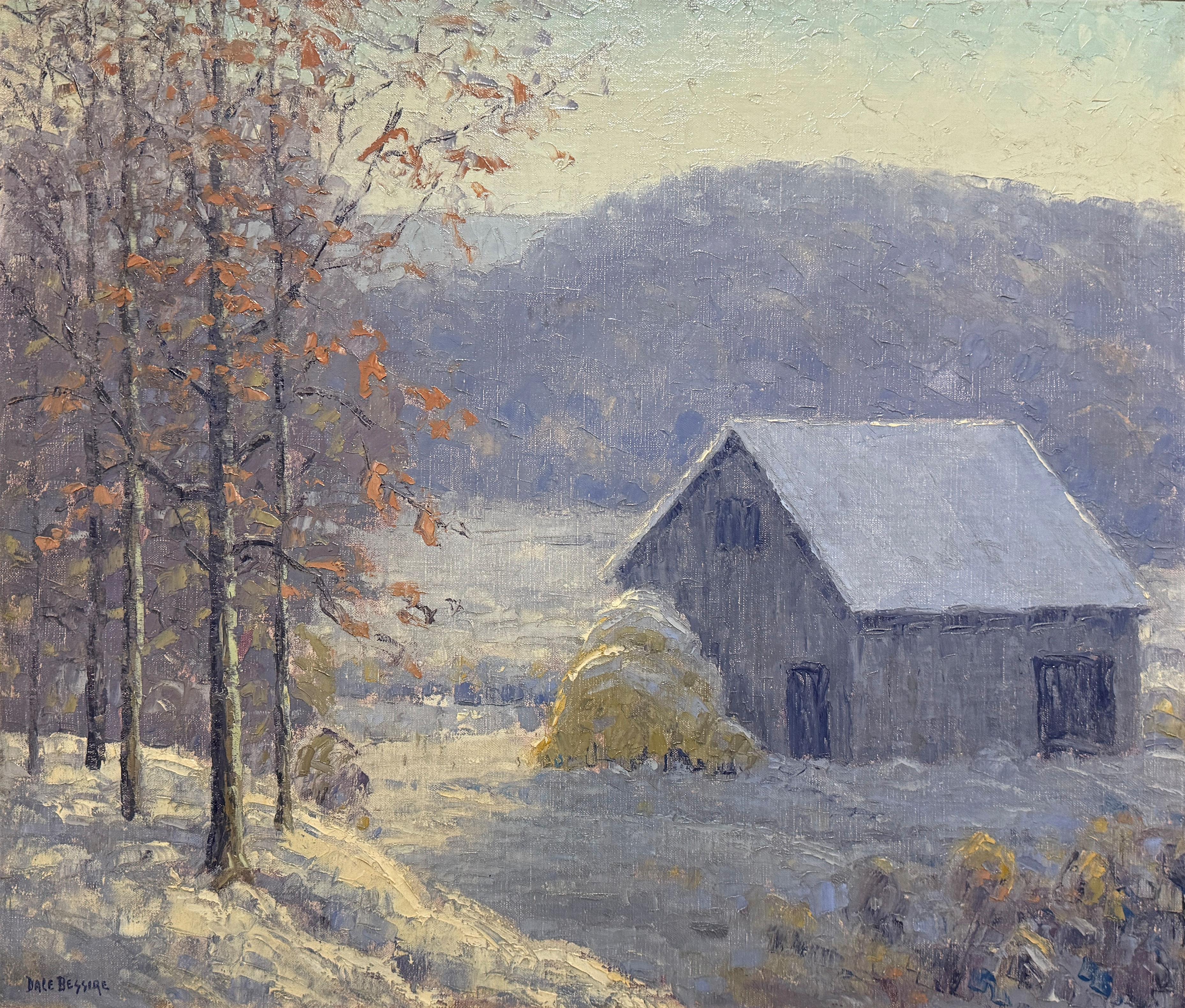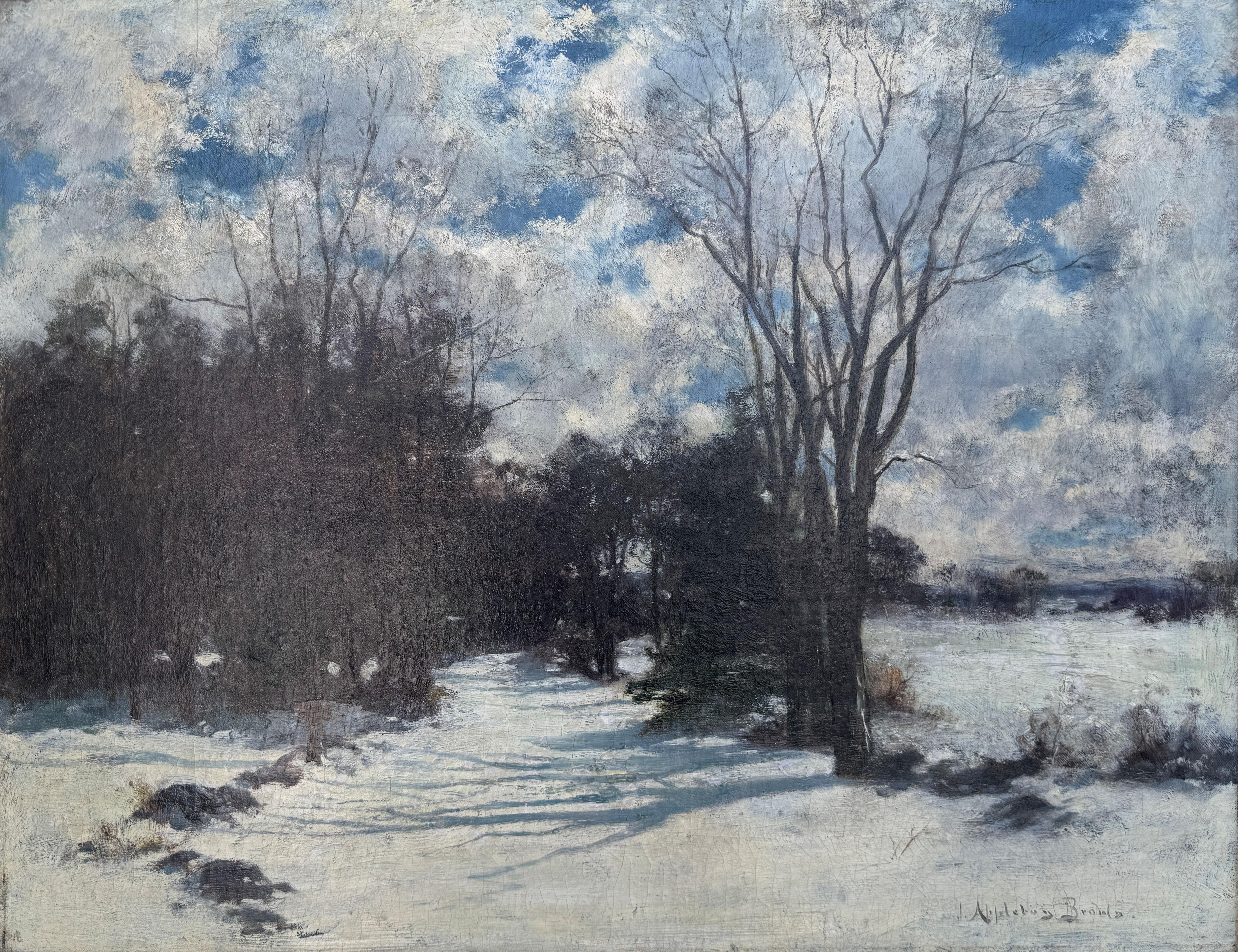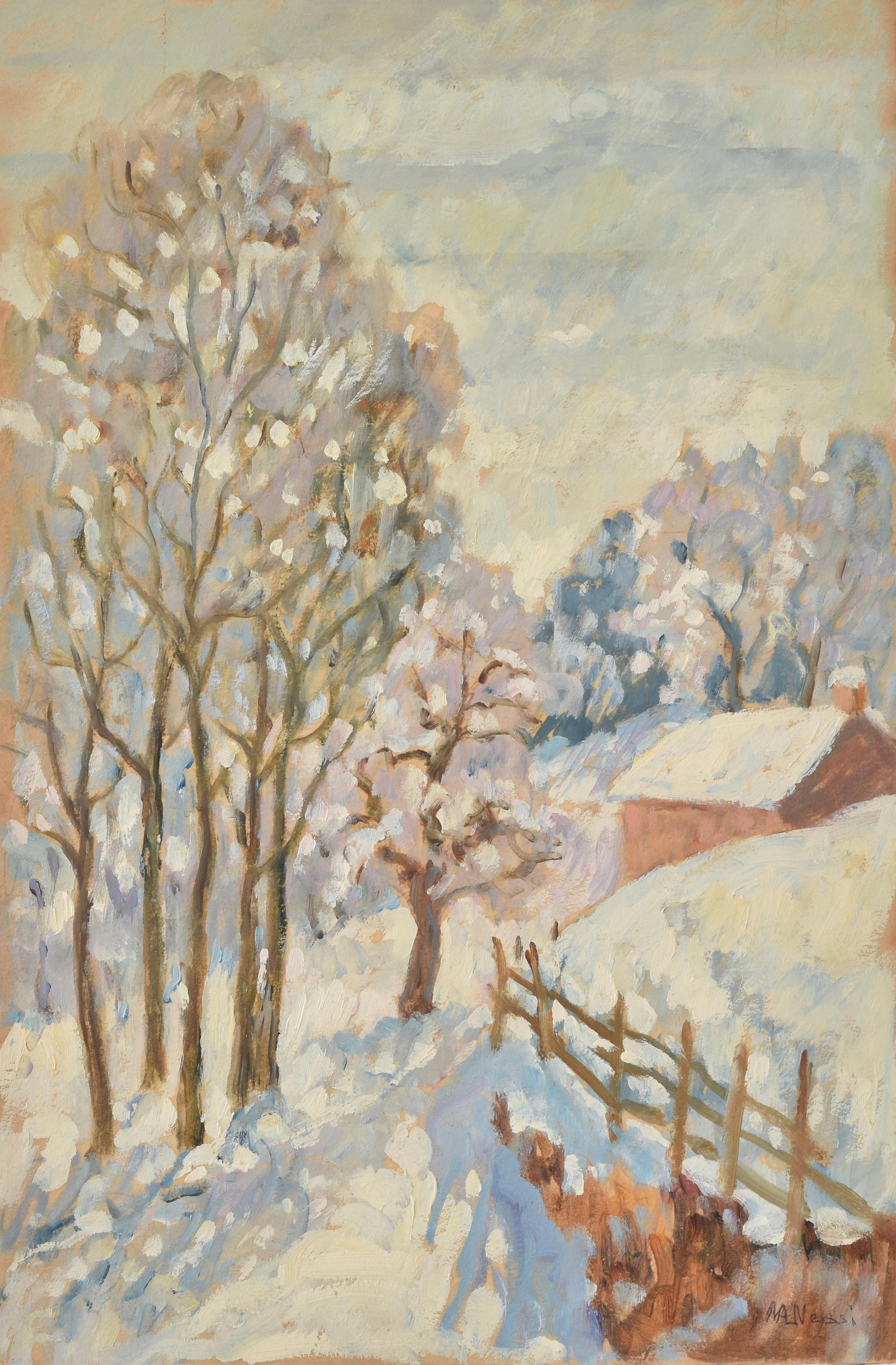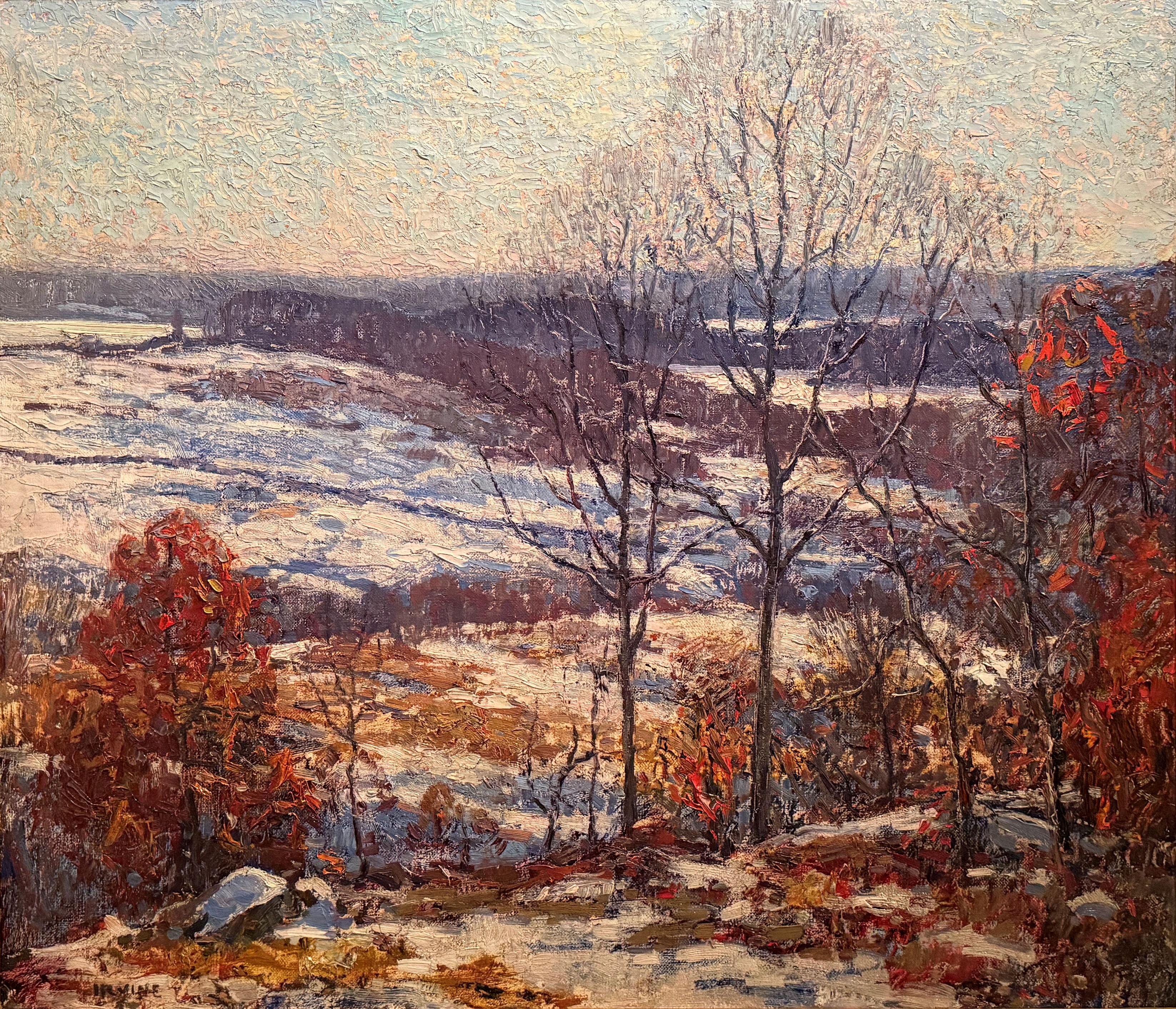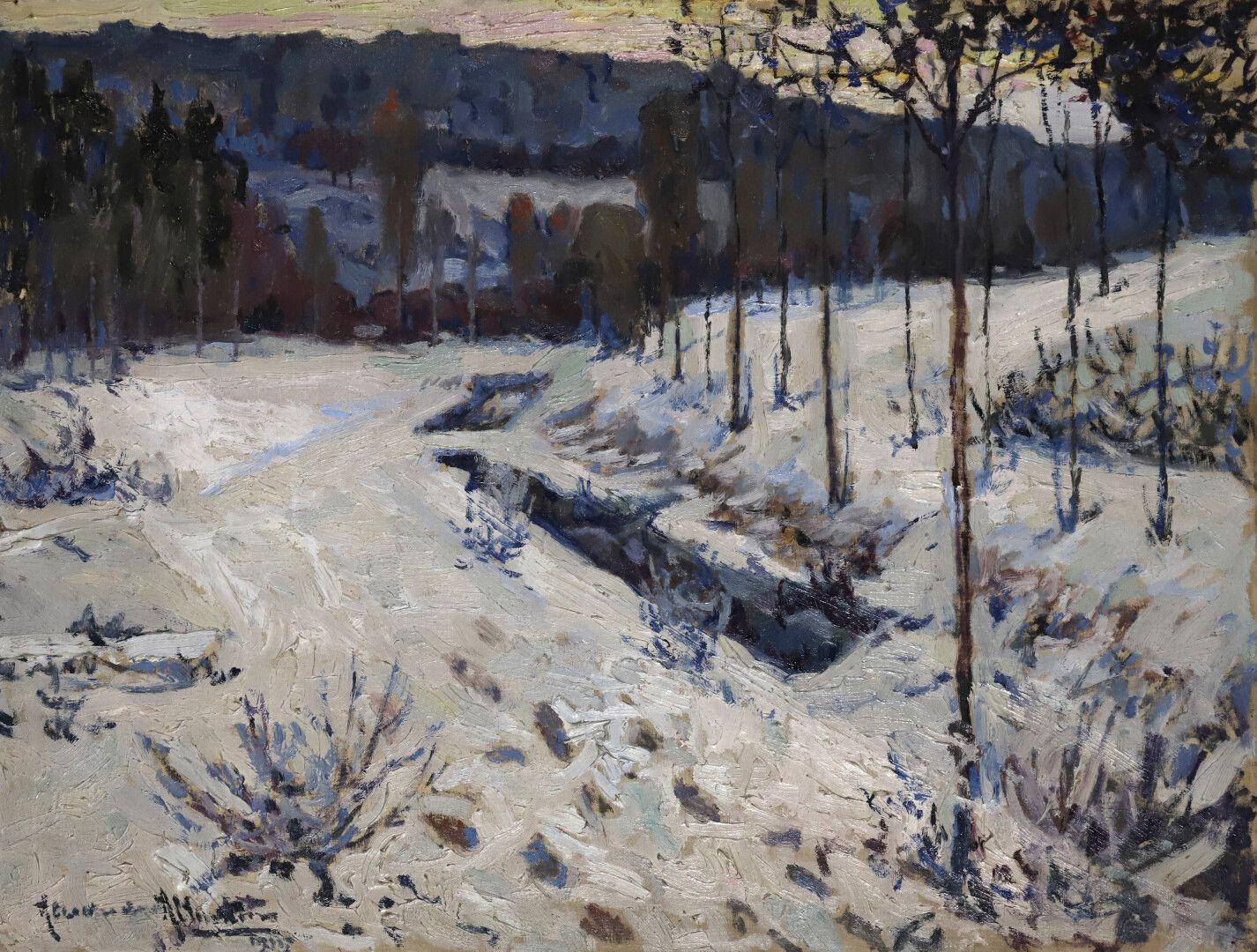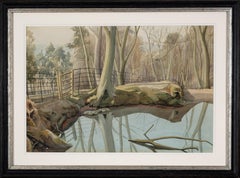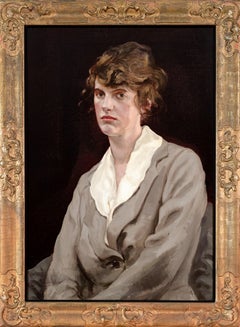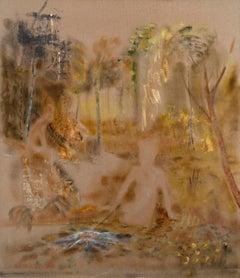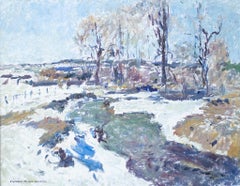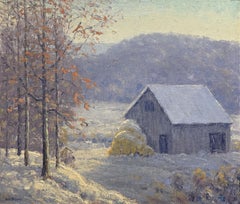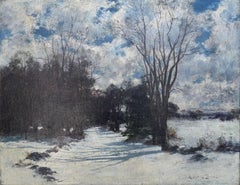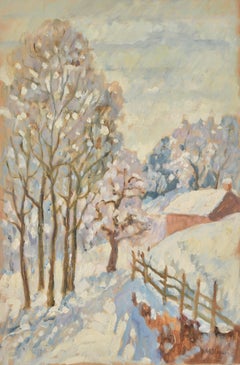Items Similar to From The Studio (Snow)
Want more images or videos?
Request additional images or videos from the seller
1 of 10
Alfred John BillinghurstFrom The Studio (Snow)1920-1940
1920-1940
$2,196.99
£1,600
€1,872.59
CA$3,030.91
A$3,331.80
CHF 1,751.04
MX$40,460.20
NOK 21,843.81
SEK 20,695.47
DKK 13,975.62
About the Item
Alfred John Billinghurst (1880-1963)
From The Studio (Snow), c. 1920-40
Oil on artist’s board
Titled and signed verso
The panel stamped with a Blanchet supplier’s mark
32.8 x 40.1 cm.
Provenance:
Bloomsbury Auctions, London, 22 November 2006, lot 7;
Private Collection, United Kingdom.
An attractive example of the British Impressionist movement, a snow-carpeted wooded clearing is observed by the artist from his studio window, who sets down an abstracted vision of a bitter landscape engulfed in the distinctive silence of snow. A gloriously subtle palette of pale blue, purple and white engulfs the clearing in a pale chilling light. Punctuated with staccato dashes of sparing green and yellow pigment, the artist suggests the gradual movement of an afternoon sun melting the ice on the leaves below. This tactile quality culminates with the illusory weight of the snow, applied in thick impasto to the delicate foliage and winter-thin branches of the central tree. A haze of blue subsumes the distant canopy in a foggy hue, capturing the visually disorientating effects of continued snowfall.
Painted by the British artist Alfred John Billinghurst, the supplier’s stencil mark of Blanchet, 38 Rue Bonaparte, Paris, dates the painting c. 1920-40. Inscriptions to the reverse of the support further identify Billinghurst’s studio as the position from which the view was painted, conceivably executed on a morning of unusual snowfall which compelled the artist to paint with such delicate immediacy an otherwise familiar view.
Alfred John Billinghurst was born in Blackheath, London, in 1880. The son of a businessman, he was educated at St. Dunstan’s College in Switzerland, after which he returned to England as a student at the Slade School in 1899. It was there that he came under the influence of Frederick Brown (1851-1941), and the early development of the British Impressionist movement. Billinghurst moved to Paris and enrolled at the École des Beaux-Arts, and later travelled throughout France and Italy to paint and study the works of the Impressionists. Upon the outbreak of war, Billinghurst enlisted in the Gloucestershire Regiment, and worked as a censor behind the front lines. In peacetime, he acquired a house and adjoining studio in East Sheen, London, and married in 1920. He enjoyed a working friendship with Lucien Pissarro (1863-1944), son of the father of Impressionism, Camille Pissarro (1830-1903). He was elected to the Royal Society of British Artists in the following year, and exhibited at the Royal Academy, Royal Institute, and Paris Salon.
Billinghurst’s sister, Rosa May Billinghurst (1875-1953), was a prominent suffragette who, having survived polio as a child, campaigned in a wheelchair. As a young woman, Rosa May Billinghurst worked to rescue young girls from prostitution, and later joined the Lewisham branch of the Women’s Social and Political Union. Taking part in the 1910 ‘Black Friday’ demonstrations, she was also complicit in the window-smashing campaign of March 1912, and in January 1913 was sentenced to 8 months’ imprisonment for damaging letters in a post box. After going on hunger strike, her condition deteriorated such that she was released only two weeks after entering prison. In May 1913, she chained herself to the gates of Buckingham Palace. She lived with her brother, Alfred, after 1914.
- Creator:Alfred John Billinghurst (1880 - 1963)
- Creation Year:1920-1940
- Dimensions:Height: 12.92 in (32.8 cm)Width: 15.79 in (40.1 cm)
- Medium:
- Movement & Style:
- Period:
- Condition:The work is in good and stable condition. The board appears to have been trimmed marginally on the horizontal edges, with little affect on the composition. Some markings verso, including pigment likely from the artist's studio.
- Gallery Location:Maidenhead, GB
- Reference Number:Seller: Alfred John Billinghurst1stDibs: LU2820215585402
About the Seller
No Reviews Yet
Vetted Professional Seller
Every seller passes strict standards for authenticity and reliability
Established in 2024
1stDibs seller since 2024
- ShippingRetrieving quote...Shipping from: Maidenhead, United Kingdom
- Return Policy
Authenticity Guarantee
In the unlikely event there’s an issue with an item’s authenticity, contact us within 1 year for a full refund. DetailsMoney-Back Guarantee
If your item is not as described, is damaged in transit, or does not arrive, contact us within 7 days for a full refund. Details24-Hour Cancellation
You have a 24-hour grace period in which to reconsider your purchase, with no questions asked.Vetted Professional Sellers
Our world-class sellers must adhere to strict standards for service and quality, maintaining the integrity of our listings.Price-Match Guarantee
If you find that a seller listed the same item for a lower price elsewhere, we’ll match it.Trusted Global Delivery
Our best-in-class carrier network provides specialized shipping options worldwide, including custom delivery.More From This Seller
View AllWoodland scene with a body of water
By John Nash
Located in Maidenhead, GB
British, 1954, Manner of John Nash (1893-1977)
Woodland scene with a body of water
Watercolour and graphite on paper, mounted to card
Signed indistinctly and dated lower left
34.1 x...
Category
1950s Post-War Landscape Drawings and Watercolors
Materials
Watercolor
Portrait of the artist’s cousin, Gladys Coombs (1899-1963), c. 1920-25
Located in Maidenhead, GB
John George Hookham (1899-1972)
Portrait of the artist’s cousin, Gladys Coombs (1899-1963), c. 1920-25
With a figure study verso
Oil on canvas
In an attractive, stylised ‘Lely’ type ...
Category
1920s Post-Impressionist Portrait Paintings
Materials
Oil
Cinder
Located in Maidenhead, GB
Joel Tomlin (b. 1969)
Cinder, 2004
Oil on linen
Signed and titled verso
183 x 157 cm.
Provenance:
Joel Tomlin;
MW Projects, London, 2004;
Permanent Collection, Saatchi Gallery;
Chri...
Category
Early 2000s Contemporary Landscape Paintings
Materials
Oil
$7,140 Sale Price
20% Off
Study for Mr and Mrs R. H. Butler and Their Daughters
Located in Maidenhead, GB
Bernard Fleetwood-Walker RA RWS (1893-1965)
Study for Mr and Mrs R. H. Butler and Their Daughters, c. 1932
Graphite on paper, mounted to card
Signed centre left
53 x 42.8 cm.; (within frame) 77.6 x 62.8 cm.
Provenance:
The artist’s studio, 1965 (no. 523);
Private Collection, United Kingdom.
Dated to c. 1932, the present drawing belongs to a series of preparatory studies for Mr and Mrs R. H. Butler and Their Daughters (1932), a large family composition...
Category
1930s Post-Impressionist Portrait Drawings and Watercolors
Materials
Watercolor
Study for Mr and Mrs R. H. Butler and Their Daughters
Located in Maidenhead, GB
Bernard Fleetwood-Walker RA RWS (1893-1965)
Study for Mr and Mrs R. H. Butler and Their Daughters, c. 1932
Graphite and coloured graphite on paper, mounted to card
Signed centre right
42.6 x 53 cm.; (within frame) 66.7 x 75.7 cm.
Provenance:
The artist’s studio, 1965 (no. 521);
Private Collection, United Kingdom.
Dated to c. 1932, the present drawing belongs to a series of preparatory studies for Mr and Mrs R. H. Butler and Their Daughters (1932), a large family composition...
Category
1930s Post-Impressionist Portrait Drawings and Watercolors
Materials
Watercolor
Study for Mr and Mrs R. H. Butler and Their Daughters
By Bernard Fleetwood Walker
Located in Maidenhead, GB
Bernard Fleetwood-Walker RA RWS (1893-1965)
Study for Mr and Mrs R. H. Butler and Their Daughters, c. 1932
Graphite, coloured graphite and wash on paper, mounted to card
64.5 x 74.5 cm.; (within frame) 87.4 x 91.8 cm.
Provenance:
The artist’s studio, 1965 (no. 525);
Private Collection, United Kingdom.
Dated to c. 1932, the present drawing belongs to a series of preparatory studies for Mr and Mrs R. H. Butler and Their Daughters (1932), a large family composition...
Category
1930s Post-War Portrait Drawings and Watercolors
Materials
Watercolor
You May Also Like
Snowy Scene with Creek
Located in Austin, TX
By Charles Berninghaus (1905-1988)
22" x 28" Oil paint on canvas
An impressionist snowy landscape painting by 20th century American artist Charles...
Category
20th Century Impressionist Landscape Paintings
Materials
Canvas, Oil
"Winter Landscape" Dale Bessire, Impressionist American Snowy Landscape
Located in New York, NY
Dale Bessire
Winter Landscape
Signed lower right
Oil on canvas
20 x 24 inches
A founding member of the Brown County Art Gallery Association, Dale Bessire was a native of Indianapol...
Category
1910s American Impressionist Figurative Paintings
Materials
Canvas, Oil
"Snowy Afternoon" John Appleton Brown, American, Snowy Landscape Barbizon School
By John Appleton Brown
Located in New York, NY
John Appleton Brown
Snowy Afternoon
Signed lower right
Oil on canvas
18 x 24 inches
Starting in 1866, John Appleton Brown trained at the Louvre in Paris under the guidance of Jean-...
Category
1880s Barbizon School Abstract Paintings
Materials
Canvas, Oil
Snow Landscape, Marie Lucie Nessi, Woman Post Impressionist, Oil paint, 1950
By Marie Lucie Nessi
Located in New York, NY
Marie Lucie Nessi-Valtat
Snow Landscape, ca. 1950
Oil on panel
16 1/10 x 10 3/4 in l 41 x 27 cm
Frame size: 18 1/10 x 13 in. l 46 x 33 cm
Marie-Lucie Nessi Valtat was a French pain...
Category
1960s Post-Impressionist Figurative Paintings
Materials
Oil
"Winter Landscape" Wilson Irvine, Atmospheric Impressionist Snowy Hills
Located in New York, NY
Wilson Irvine
Winter Landscape
Signed lower left
Oil on canvas
24 x 27 inches
A prolific Impressionist with a penchant for atmospheric scenes, Illinois native Wilson Irvine began h...
Category
1910s American Impressionist Figurative Paintings
Materials
Canvas, Oil
Snowy Landscape, 1915
By Alexandre Altmann
Located in Paris, Île-de-France
Alexandre Altmann (1878-1932)
Snowy Landscape, 1915
Oil on canvas, 50 x 65 cm
Provenance:
Private collection, France
Captured in the winter tones of 1915 by Alexandre Altmann, 'Sn...
Category
1910s Post-Impressionist Landscape Paintings
Materials
Oil
$14,400 Sale Price
33% Off
More Ways To Browse
Used Wheelchairs
1920 Oil On Board
A Blanchet
Black Friday
Antique Wheelchair
Antique Post Box
Modern Barn Art
Mountain Stream Painting
Oil Painting Botanical Garden
Oil Paintings Capri
Original Desert Landscape
Pacific Northwest Landscapes
Paintings Missouri
Paintings Of Lavender
Roma Oil Paintings
Venice San Giorgio
Vintage Barn Signs
Vintage Mathews
